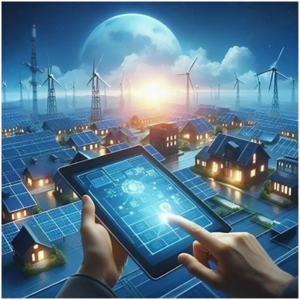
By 2050, solar energy could meet nearly 50% of global electricity demand—but only if efficiency challenges are addressed. AI and IoT are emerging as key solutions.
As the world rapidly shifts toward more sustainable energy sources, solar energy stands at the forefront of this global transition. Countries are striving to reduce carbon emissions and combat climate change, and solar power has proven to be one of the most viable renewable energy sources. According to the International Energy Agency (IEA), solar photovoltaic (PV) capacity grew by nearly 26% in 2023, with projections indicating continued acceleration. Falling costs of solar panels, advancements in energy storage, and supportive government policies are driving this adoption.
However, this transition is not without its challenges. Integrating solar power into the existing energy mix presents difficulties, especially in ensuring reliability, efficiency, and scalability. While traditional solar systems have significantly contributed to energy generation, their performance is often limited by unpredictable weather patterns, maintenance issues, and a lack of intelligent monitoring. These limitations stem from the inherent unpredictability of solar energy and the extensive infrastructure necessary for its widespread implementation. Conventional solar energy systems lack real-time monitoring capabilities, making it challenging to predict performance trends. Without advanced analytics, solar farms struggle to optimise energy generation, storage, and distribution. Occasionally, challenges arise in grid integration due to the inability to accurately forecast demand and supply fluctuations.
This is where Artificial Intelligence (AI) and the Internet of Things (IoT) come into play. These technological tools are revolutionising solar energy by enhancing performance, efficiency, and reliability. They enable predictive maintenance, real-time energy optimisation, and smart grid integration. This article explores how AI and IoT transform solar energy systems and enhance performance to ensure energy reliability. Before delving into how these technologies enhance performance, let’s examine the current state of solar energy systems.
Current State of Solar Energy Systems

Modern solar energy systems are built on three key components:
- Photovoltaic (PV) Panels: These are the primary technologies for converting sunlight into electricity. The most common types are monocrystalline, polycrystalline, and thin-film panels, each with varying efficiency levels.
- Inverters: Since PV panels generate direct current (DC) electricity, inverters convert it into alternating current (AC) for use in homes, businesses, and the grid. There are string inverters, microinverters, and hybrid inverters, each suited for different applications.
- Energy Storage Systems: Batteries, such as lithium-ion and flow batteries, store excess solar energy for later use, ensuring power availability during non-sunny hours. Advanced systems include smart battery management systems (BMS) that regulate charging and discharging cycles.
While these components have made solar power more accessible and scalable, traditional operations still face several inefficiencies that limit their full potential.
Limitations in Current Solar Systems
- Manual Maintenance Approaches: Most solar farms rely on scheduled or reactive maintenance, where technicians inspect and repair issues only after a failure occurs. Physical inspections are labour-intensive and costly and often miss early signs of degradation. Issues like dust accumulation, wiring faults, and inverter failures can go undetected, reducing efficiency and causing unexpected downtime.
- Inefficiencies in Energy Distribution and Storage: Intermittency remains a challenge, as solar generation depends on weather conditions, leading to fluctuations in power output. Traditional grid systems struggle to integrate solar energy, resulting in curtailment (wasted solar energy) when supply exceeds demand. Battery storage is often underutilised due to a lack of smart management systems that can optimise charging and discharging cycles based on real-time data.
With the increasing adoption of solar energy, automation and intelligent control systems are essential for improving efficiency and reliability. Integrating AI and IoT technologies offers several advantages, which include predictive maintenance using AI-driven fault detection and diagnostics, real-time energy optimisation through IoT-based sensors and analytics, automated demand response to ensure seamless solar-grid integration, and smart battery management to enhance energy storage efficiency. To overcome such limitations, the solar industry is integrating AI-driven analytics and IoT-enabled automation. These technologies are revolutionising solar performance by enabling predictive maintenance, optimising energy distribution, and enhancing grid integration.
Artificial Intelligence in Solar Energy Systems
Artificial Intelligence refers to machine-based systems that simulate human cognitive functions and processes, and its application in solar energy systems is transforming the industry. AI is not just about automation but also about enhanced decision-making and predictive intelligence. In solar energy systems, AI can process vast amounts of data, recognize patterns, and make intelligent predictions that improve efficiency.
AI-Powered Demand-Supply Balancing
Solar energy production is inherently variable, while energy demand fluctuates throughout the day. AI bridges this gap by analysing historical energy consumption trends, weather forecasts, and grid demand to adjust solar panel tilt for maximum sunlight absorption, optimize energy storage and release based on peak demand periods, and prevent grid overload by diverting excess energy to storage or alternative applications.
A real-life example is Google’s DeepMind AI, which has helped utilities optimise energy consumption, resulting in a 40% reduction in cooling costs for data centres. A similar AI-driven approach could revolutionise solar grid management by balancing energy distribution efficiently.
AI-Enabled Energy Yield Forecasting

Traditional solar energy forecasting is based on static weather models. AI takes forecasting to the next level by integrating machine learning algorithms that analyse cloud patterns, air pollution levels, and past weather events, satellite imagery to detect atmospheric conditions that affect sunlight absorption, and neural networks that predict how much power a solar farm will generate at any given time with up to 95% accuracy. AI-based forecasting can reduce solar curtailment by up to 30%, ensuring that more renewable energy is efficiently integrated into the grid.
How does IoT help in Solar Energy Systems?
The Internet of Things is one of the top solutions for making solar energy systems more cost-efficient. Using the granular data offered by smart IoT gateways and sensors, users can gain insights into their solar energy systems to make them more efficient. In this article, we explore the role of industrial IoT gateways in solar energy and how they can benefit users.
IoT, or the Internet of Things, is a network of connected devices. These devices can communicate with each other, and since they’re usually connected to the broader internet, users can access and control them remotely via mobile apps or web consoles. IoT devices are commonly used in smart apartments, industrial automation, smart agriculture, and many new applications.
They are primarily sensors, actuators, or a combination of both. For example, a digital assistant device usually has a couple of microphones to capture users’ commands and speakers’ replies. A smart sprinkler used to water the garden will have a solenoid valve to control the water flow and moisture sensors to check the water content in the soil.
These devices send their data to a smart gateway, which may send commands directly to the device or send the data to the cloud for further processing. Users can then view the data and control the devices through smartphone or desktop apps.
How IoT and Solar panel systems work together.
The Internet of Things offers a ton of granular data and control that was previously impossible for any business or system. Sensors can collect heat, temperature, sound, vibrations, motion, and other data from equipment and systems. Once analysed, this data can reveal patterns, trends, and inefficiencies affecting the system.
As a result, solar panel monitoring has become the mainstream solar energy IoT project. IoT-based solar panel monitoring keeps track of each panel in a network. Solar panel monitoring systems may measure and record the current, voltage, irradiance, and temperature of many solar cell units, as well as external elements like dirt or debris on the panels and external damage. Solar energy is a highly complex system with many different components. If any of these components are not working efficiently, the energy output of the entire system can be reduced. However, due to its large size, operators often struggle to gain enough visibility into it. Monitoring solar panels enables the identification of deteriorations or places of failure down to the individual panel.
This is what the Internet of Things can change. It can make the entire system more transparent and help operators spot issues and inefficiencies that may be holding them back from peak efficiency.
Applications of IoT in Solar Energy
The range of sensors and IoT devices available right now opens up a whole world of applications in solar energy. They can transform how energy systems are managed and give operators and stakeholders more visibility. Here are a few applications of IoT in solar energy.
Asset Management
Solar energy systems are usually made of multiple solar panels, all connected to produce energy. For instance, in a 1 MV solar farm, there may be around 2,500 solar panels. It is simply not easy to manage these panels manually, particularly when even a minor issue with one of them can significantly reduce energy production. Besides the panels, other components manage the systems and store and distribute the energy. To ensure uninterrupted energy production, these systems must work without a glitch and be monitored constantly. This is where IoT can help. IoT sensors can continuously monitor the health of these panels and send real-time updates to the operators. Sensors can collect temperature, heat, tilt angle, and other data, which the operators can then use to optimise the system. With this, companies can significantly improve the uptime of their energy systems and ensure sustained energy production. Operators can also conduct automated tests regularly and use the data to make a long-term plan

Streamlined Maintenance
Solar farms or even small solar energy systems require regular maintenance. If the panels are covered with dust or other debris, their energy efficiency can decrease.
However, performing this maintenance manually will be resource-intensive and can prove too expensive in the long run. With IoT solutions, companies can streamline their maintenance process and reduce the associated costs. If any panels or energy storage systems are facing issues, operators can detect them quickly and, to a large extent, diagnose the problem with the sensor data. If they detect low energy production or the system goes down, the operators won’t have to go through individual components manually to figure out the issue. They can simply check out their dashboard and quickly identify the affected components. Companies can also use IoT data to predict when equipment may fail or need maintenance. Generally, organisations conduct maintenance activities regularly, even if the components work well.
In some cases, they may opt to leave them alone until they break down. As you can imagine, both approaches have drawbacks and can be costly. However, with predictive maintenance from the IoT data, they can significantly reduce the maintenance expenditure without increasing the risk of a shutdown.

Improve the Security of the Panels and Infrastructure
Solar energy infrastructure is expensive. On average, the cost of solar panels in the United States is $24,742, in addition to batteries and other equipment. A large-scale solar farm takes a considerable investment to build and maintain. If these panels are stolen or vandalised, they can be a bit expensive for the company.
Operators can use IoT tracking and monitoring devices to monitor their infrastructure. They can configure alerts that will go off if a panel or a component is disconnected or is not producing energy. This can help prevent theft or vandalism to a large extent. Additionally, they can use this same tech to track and replace malfunctioning components.
Improved Energy Management

While solar energy produces enough energy output to make a sustainable ROI, there’s considerable variation throughout the year. Even minor inefficiencies can make a big difference over time. Previously, operators didn’t have enough data to optimise their infrastructure. With IoT, operators can get the complete picture of their infrastructure through IoT sensors. Companies can collect granular data over their entire infrastructure and find energy production and usage patterns throughout the year. They can better predict the energy outputs and use them to optimise their systems. They can adjust the pricing and store more energy to ensure a consistent supply if low energy production is anticipated. Even small-scale solar energy systems, such as those at homes and offices, can use IoT to optimise their energy savings.
The Convergence of AI, IoT, and Blockchain in Solar Energy
Incorporating blockchain technology into AI and IoT-driven solar energy systems further enhances security, transparency, and decentralized energy trading.
Blockchain-Powered Peer-to-Peer (P2P) Energy Trading
With decentralised solar grids, households or businesses can sell excess energy directly to other consumers. Blockchain makes this possible by automating energy transactions using smart contracts, ensuring transparent and tamper-proof energy tracking, and reducing dependence on centralized utilities. For example, the Brooklyn Microgrid project in New York enables local solar energy producers to trade surplus electricity via blockchain, reducing reliance on fossil fuels.
Enhanced Grid Security with AI and Blockchain
Cybersecurity threats pose a risk to smart solar grids. AI and blockchain work together to detect and prevent hacking attempts by analyzing network activity in real time, ensuring data integrity in IoT-enabled energy transactions, and protecting critical infrastructure from grid disruptions caused by cyberattacks. Siemens, for example, has integrated blockchain and AI-driven cybersecurity in European smart grids to prevent unauthorized access and enhance grid resilience.
AI and IoT in Off-Grid and Rural Solar Solutions
AI and IoT-driven solar microgrids are bridging the energy gap in regions without stable electricity access.
AI-Optimized Microgrid Systems
Microgrids use solar panels and batteries to power rural communities. AI enhances efficiency by predicting energy demand patterns based on community usage trends, optimising battery storage to extend lifespan and minimise waste, enabling autonomous energy distribution, and ensuring a stable power supply. In Kenya, AI-driven solar microgrids have increased electricity reliability by 60%, supporting businesses and households.
IoT-Enabled Smart Meters for Pay-as-You-Go (PAYG) Solar
Many off-grid communities use PAYG solar models, where users pay for energy based on consumption. IoT-powered smart meters enable real-time billing and remote activation, automated maintenance requests when system faults occur, and data-driven pricing models to make solar more affordable. Companies like M-KOPA Solar in Africa have provided over 1 million households with solar energy using IoT-based PAYG systems.
Future Prospects of AI and IoT in Next-Generation Solar Innovations
Looking ahead, AI and IoT will drive breakthrough innovations in solar technology.
AI-Enhanced Perovskite Solar Cells
Perovskite solar cells offer higher efficiency at lower costs than traditional silicon panels. AI is accelerating its development by analyzing material compositions to improve durability, simulating real-world performance to optimize design before production, and enhancing automated manufacturing processes to scale production. AI-driven research has helped improve perovskite cell efficiency to over 30%, making them a game-changer for the future of solar energy.
IoT-Enabled Floating Solar Farms
With land scarcity becoming a challenge, floating solar farms on water bodies are gaining traction. IoT sensors help manage these systems by detecting water movement to prevent panel damage, monitoring algae growth and water quality to minimise environmental impact, and adjusting panel orientation for maximum sunlight absorption. China’s Anhui Floating Solar Plant, the world’s largest, uses IoT-driven automation to enhance efficiency and reduce operational costs.
AI-Powered Solar-Powered Electric Vehicle (EV) Charging
As EV adoption rises, AI will be crucial in optimising solar-powered charging stations by predicting charging demand based on traffic patterns, directing excess solar energy to fast chargers during peak hours, and enabling dynamic pricing models based on grid demand.
AI-powered solar EV charging hubs in California are reducing carbon emissions by over 75% compared to traditional charging stations.
Conclusion: AI and IoT are the Future of Solar Energy
Integrating AI and IoT in solar energy systems is a game-changer. It addresses inefficiencies, optimises energy use, and enhances sustainability. These innovations, from smart grids and predictive maintenance to AI-driven forecasting and decentralised energy trading, are making solar power more reliable, cost-effective, and accessible. To unlock the full potential of solar energy, industry leaders must invest in AI research and IoT infrastructure, implement blockchain-based energy trading systems, and expand smart solar solutions for rural electrification. By leveraging AI and IoT at scale, solar energy will become the dominant force in the global energy transition, accelerating the shift toward a cleaner, smarter, and more sustainable future.
About the Author

Daniel Maduagwu, PMP, is an influential energy executive and the Founder & CEO of 3KM Energy Systems, with over 20 years of leadership experience in renewable energy, power systems, and telecom infrastructure across Sub-Saharan Africa. Known for his strategic mindset and results-driven approach, Daniel has successfully steered complex projects, including national energy transition programs, and pioneered models to accelerate clean energy adoption in commercial and industrial sectors. His leadership is defined by a deep commitment to sustainability, innovation, and empowering teams to deliver measurable impact. Daniel continues to shape the future of energy through bold thinking, digital transformation, and a relentless focus on customer value.
Connect with Daniel Maduagwu on LinkedIn.
Find 3KM Energy Systems on LinkedIn or visit https://3kmenergy.com/
Also Read :-
Redefining The Financial Landscape: Khaled Makhlouf
Abdulrahman Alsheail: Leading with People, Shaping Institutions








